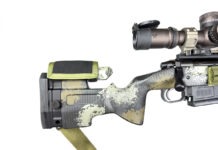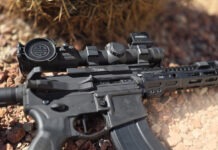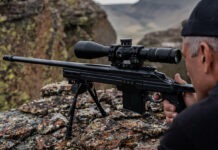Gun Digest Contributor Phil Massaro takes us through the basics of understanding barrel twist rate.
What is twist rate, and why is it important in selecting the right bullet and rifle for your intended purpose?
- Twist rate is the ratio of how tight the rifling spirals are in your barrel.
- Twist rates are expressed by a ratio that starts with 1 (1:7, 1:10, 1:14, etc.).
- Tighter, faster twist rates are needed to stabilize longer, heavier bullets.
- When a longer bullet encounters a slow twist rate, it becomes unstable.
- This affects the trajectory and the way the bullet impacts the target.
Most shooters, even those relatively new to the sport, have heard of or are familiar with “twist rate” in some way, even if it's just by looking at the ratio stamped onto a rifle's barrel. However, if you intend to get the most out of your rifle, it's something you need to know and understand.
In the video above, Gun Digest Contributor Phil Massaro explains the basics of twist rate. In short, he says, twist rate is a ratio describing how tight the spirals, or rifling, are in your rifle's barrel.
This is important because some twist rates, especially those referred to as “slow” or “slower” — which translates to fewer rotations before the bullet exits the barrel — don't provide enough rotation to properly stabilize longer, heavier bullets. A lot of great varmint guns feature a barrel with a relatively slow twist rate because the bullets being used are very lightweight, and that twist rate adequately stabilizes them by spinning them faster.
Bullets intended for use on larger game for serious long-range accuracy are generally heavier and longer. The reason longer bullets are used for shooting at longer ranges is because they are sleeker and generally offer an improved ballistic coefficient — they are more aerodynamic and less prone to wind interference and atmospheric drag.
Of course, the use of these longer, heavier bullets requires a tighter, faster twist rate that can properly stabilize them in flight. Otherwise, you end up with a bullet that does not fly properly and which might be inaccurate or hit the target incorrectly (sideways, for example).
Check out the video above to get the straight scoop from Massaro. And be sure that you're keeping twist rate in mind when selecting your rifle and bullet combination.

Next Step: Get your FREE Printable Target Pack
Enhance your shooting precision with our 62 MOA Targets, perfect for rifles and handguns. Crafted in collaboration with Storm Tactical for accuracy and versatility.
Subscribe to the Gun Digest email newsletter and get your downloadable target pack sent straight to your inbox. Stay updated with the latest firearms info in the industry.




![Best Concealed Carry Guns In 2025 [Field Tested] Wilson Combat EDC X9S 1](https://gundigest.com/wp-content/uploads/Wilson-Combat-EDC-X9S-1-324x160.jpg)


![Best 9mm Carbine: Affordable PCCs [Tested] Ruger Carbine Shooting](https://gundigest.com/wp-content/uploads/Ruger-Carbine-Shooting-100x70.jpg)
![Best AR-15: Top Options Available Today [Field Tested] Harrington and Richardson PSA XM177E2 feature](https://gundigest.com/wp-content/uploads/Harrington-and-Richardson-PSA-XM177E2-feature-100x70.jpg)

Everything said is correct.
But… (there’s always a ‘but’ with me)
The “1:7” means the bullet does one complete revolution in seven inches of barrel travel. This spin rate does not slow down nearly as quickly as bullet velocity. It certain does not slow down in direct correlation to forward velocity once the bullet leaves the barrel.
“Twist Rate” is NOT a specific rate for a specific bullet. It is more a range of use function. The thirty caliber bores (usually .308″) are typically manufactured to have a 1:10 twist. This began (in the United States) with the .30-40 Krag rifle and cartridge which used a 220 grain, round nosed FMJ bullet. The M1903 initially used a load very similar to the Krag (220 grain RN-FMJ) and therefore had the same twist. After the adoption of the M1906 bullet (hence .30-06) the bullet weight was reduced to 150 grains (more or less). This would – according to the formula – require a slower twist rate; however, the Govmint found the lighter bullet round worked just fine with the tighter twist. Since then, many reloaders have found bullet down to 125 grains will do quite nicely and even the 100 grain “plinker” bullets do fine with the original 1:10 twist.
The same effect or result applies to the 6.5×55 Swede. Initially, the bullet weight was 160 grains and the twist rate was 1:7. Now, one can load a 120 grain bullet (or anything in between) and get satisfactory results.
On the other hand, I have similar experience with the .22-250 Remington. It does fine with 50-55 grain bullets, even superlative. It will pretty well (not great) stabilize the 70 grain RN (soft point) Speer bullet and absolutely will NOT stabilize the 69 grain Sierra boat tail, Spitzer point (it’s just a bit too long). (Rifle spin rate is 1:12 if I remember correctly.)
The conclusion is, a great deal of overspin is better than just a little bit of underspin. Yes, one can spin a bullet so fast it becomes unstable, but one must work at it.
However, unless one is building a custom rifle (or barrel), the manufacturer sets the twist rate when they make the barrel. So one determines the twist rate and chooses bullets accordingly for us folk who buy commercial products. (It is easier to buy another box of bullets than to re-barrel.)